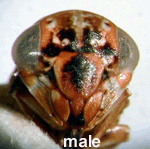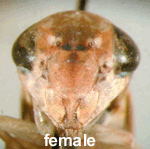Idioscopus nitidulus (Walker)
Caution
Many of the insects depicted on these pages are outwardly similar and you should not use photographs as the sole means of identification. These pages form part of a scientific key which will assist a trained entomologist to identify the species accurately.



Idioscopus nitidulus (Walker 1870)
Distribution: I. nitidulus was first collected in Australian territory on Yam Island and Darnley Island in Torres Strait in 1986 (Day and Fletcher 1994). By 1997 it had spread to Weipa in North Queensland and Darwin in the Northern Territory. In the Oriental region it occurs in India, Sri Lanka, Burma, China, Taiwan, Japan, the Philippines, Indonesia and Malaysia. It presumably also occurs in New Guinea.
Economic Status: This is one of the most serious leafhopper pests of mangos found in the Oriental Region with most published research being undertaken in India and Taiwan. I. nitidulus feeds by preference on new leaves and flowers causing wilting and flower drop which reduces fruit yield. Feeding in large numbers also encourages heavy growths of sooty moulds which affect the marketability of the fruit.
Natural Enemies: Several species of microhymenopteran
parasitoids (in particular Gonatocerus sp, Mymaridae) have been
identified from Idioscopus spp in Taiwan (Chou and Chou 1990)
and India (Fasih and Srivastava 1990).
In addition, a number of entomophagus fungi have
been recorded from I. nitidulus including Beauveria bassiana
in India (Tripathi
et al. 1990)
Verticillium lecanii in India (Viraktamath
et al.
1994) and Hirsutella
versicolor in Malaysia (Lim and Chung 1995).
Predators of the leafhoppers recorded overseas include chrysopid lacewings
and spiders.
Notes: This species is better known in the literature under the name Idioscopus niveosparsus Lethierry (1889). It is larger and darker in colouration than I. clypealis which was first recorded in Australia in October 1999.



